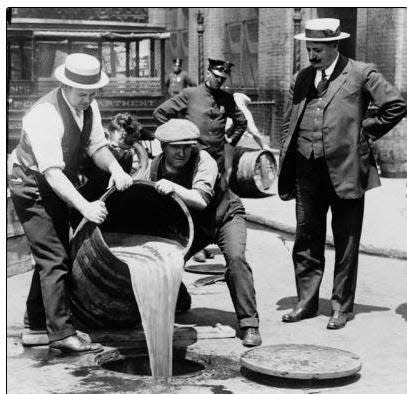Prohibition-era bootleg bust with a hail of gunfire was a photo assignment like no other
Prohibition agents had gathered enough evidence to make a sweep through southern Delaware searching for illegal booze.
The raiding party, composed of federal state and local law enforcement officers, left Georgetown at 4 a.m. in the morning on Dec. 12, 1924. They headed for Roxana, where there were reportedly moonshiners who had set up a still so large that the police enlisted photographer Albert H. Waller of Laurel to document the raid.
It was an assignment that Waller would not soon forget.
Born around 1875, Waller established his Laurel photographic studio in the last years of the 19th century, when the photographer began documenting life in and around Laurel, one of the largest towns in southern Delaware. Using his Laurel studio as his base, Waller spent a half-century photographing everyday scenes of life in southern Delaware.

In 1919, when the 18th Amendment to the Constitution was ratified in order to outlaw the manufacture, sale or transportation of intoxicating liquors, bootleggers established illegal stills in the Great Cypress Swamp and other isolated areas of Sussex County.
Federal, state and local authorities were determined to put an end to the illegal manufacture of booze, but when the prohibition agents arrived at Clarence Lynch’s farm near Roxana, they did not find any evidence of an illegal still.
However, on the adjoining farm, the prohibition agents found a 25 gallon still. The still was not currently running, but searching further, the agents found ten barrels containing 50 gallons of fermented mash each.
Most Delaware moonshiners set up stills to produce distilled liquor. According to Eric Mills in "Chesapeake Rumrunners of the Roaring Twenties," “The basic still setup is simple … There’s the main boiler kettle, called the ‘cooker,’ or ‘can.’ In here is the grain — cornmeal, rye, barely, whatever — mixes with distilled water, sugar, and though purist would argue but expediency would dictate, yeast to cause fermentation.”
PARK GUIDE: Delaware Seashore State Park guide: 5 things to do, admission, eats and more
MORE ON PROHIBITION: How the end of Prohibition era rang in 1933 with major changes for Delaware
This mixture, called ‘mash,’ was allowed to ferment for a few days and then heated at a low temperature to allow the alcohol to boil off. The alcoholic vapor is condensed in a coil encased in cold water to produce the liquid spirits.
The mash barrels near Roxana had been partially buried in a trench, and pine slats had been used to camouflage them. It was reputedly the biggest bootleg bust in the state, and Waller set to work photographing the illegal booze-making operation.
He took a photo showing the layout of the mash barrels and other apparatus and a second photo with the Prohibition agents lined up on one side of the distilling operation.
Suddenly, his picture-taking was interrupted by the sharp, crackling sound of gunfire. According to the Laurel State Register, “The officers were bombarded with rifle shots.”

The agents returned fire, but they were in the open, and their assailants were hidden in the woods. The firing was so intense that several tree limbs were shot off and fell amid the still and the barrels of mash. When the agents realized that they could not see the moonshiners, the lawmen decided to abandon the still. The retreating lawmen made their way out of the woods to their cars and drove off.
The Prohibition agents had raided arguably the biggest still in southern Delaware, and Albert Waller who normally took photographs in more sedate settings, had a picture session like no other.
Principal sources
State Register, Jan. 24, 1925.
Laurel Historical Society Newsletter Spring 2014.
Town of Laurel Delaware Newsletter, Winter Edition, 2022.
Eric Mills, Chesapeake Rumrunner of the Roaring Twenties, Centreville, MD: Tidewater Publishers, 2000, p. 37.
This article originally appeared on Salisbury Daily Times: How a photographer recorded Prohibition-era raid under gunfire
